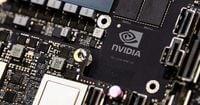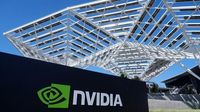NVIDIA is making significant strides in reshaping the landscape of artificial intelligence manufacturing in the United States. The company has announced plans to produce AI supercomputers entirely on American soil for the first time, marking a pivotal moment for both the tech giant and the U.S. semiconductor industry.
As of April 14, 2025, NVIDIA has started production at a factory in Phoenix, Arizona, where it is producing its Blackwell chips at the facilities run by Taiwan Semiconductor Manufacturing Company (TSMC). In a bold move, NVIDIA has commissioned over a million square feet of manufacturing space in Arizona for building and testing these chips, while also establishing supercomputer manufacturing plants in Texas—specifically in Houston with Foxconn and in Dallas with Wistron.
Jensen Huang, NVIDIA's founder and CEO, emphasized the importance of this initiative, stating, "The engines of the world’s AI infrastructure are being built in the United States for the first time. Adding American manufacturing helps us better meet the incredible and growing demand for AI chips and supercomputers, strengthens our supply chain and boosts our resiliency." This statement encapsulates the ambitious vision NVIDIA has for its future operations.
The company is not just stopping at chip production; it is also investing in the complete lifecycle of AI supercomputers, which includes packaging, assembly, and testing. To facilitate this, NVIDIA is partnering with Amkor Technology and Siliconware Precision Industries (SPIL) for packaging and testing operations in Arizona. This collaboration is part of a broader strategy to bolster the U.S. supply chain for semiconductors and AI technologies.
Over the next four years, NVIDIA plans to invest up to half a trillion dollars in AI infrastructure through its partnerships with TSMC, Foxconn, Wistron, Amkor, and SPIL. This extensive investment is expected to create hundreds of thousands of jobs and drive trillions of dollars in economic security for the nation.
Amidst geopolitical tensions and changes in global trade policies, NVIDIA's expansion comes at a critical time. The company aims to reduce reliance on overseas production and improve supply chain resilience within the U.S. market. This shift is particularly timely as the Trump administration has announced tariffs on semiconductor imports, which could impact the industry significantly.
In a statement reflecting the administration's support for domestic manufacturing, the White House remarked, "Onshoring these industries is good for the American worker, good for the American economy, and good for American national security—and the best is yet to come." This sentiment aligns with NVIDIA's goals of fostering a robust U.S. semiconductor industry.
As part of its commitment to innovation, NVIDIA plans to utilize its advanced AI, robotics, and digital twin technologies to design and operate these new facilities. The company will implement its Omniverse platform to create digital twins of factories, which allows for simulation and optimization of manufacturing processes before actual implementation. Additionally, NVIDIA will employ its Isaac GR00T robots to automate crucial production tasks.
The anticipated mass production at the Texas plants is expected to ramp up within the next 12 to 15 months, further accelerating NVIDIA's efforts to meet the surging demand for AI technologies. The company’s AI supercomputers are integral to powering modern data centers, which are increasingly becoming the backbone of the burgeoning AI industry.
NVIDIA's initiative is not just a technological advancement; it is also a strategic move to mitigate exposure to global supply chain shocks, particularly in light of recent trade wars and policy changes. The company’s expansion is poised to create a significant number of new jobs across various sectors, including manufacturing, logistics, and technology services.
The ripple effect of NVIDIA's investment could lead to widespread economic growth, positioning the U.S. as a leader in AI infrastructure development. With tens of “gigawatt AI factories” expected to be built in the coming years, the potential for job creation and economic stimulation is immense.
In conclusion, NVIDIA's commitment to establishing a robust AI manufacturing presence in the United States signifies a transformative shift in the semiconductor landscape. With substantial investments and strategic partnerships, the company is not only addressing the immediate demands of the AI market but also laying the groundwork for long-term economic resilience and innovation in the tech industry.



